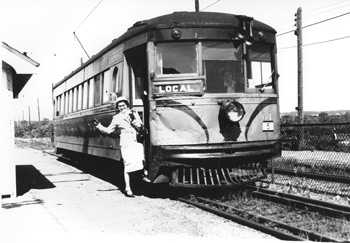History
History of “The Milwaukee Electric Railway & Light Company”
Chronology History of Early Transportation
1859- 1885
July 1, 1859
River & Lake Shore City Railway Organized.
August 1, 1859
Petition to Common Council for street railway from North Point to Walker’s Point Bridge, Cyrus D. Davis, President.
October 31, 1859
Ordinance given to Fifth and Eighth ward to operate south from Walker’s Point Bridge to Layton House.
The Milwaukee Electric Railway & Light Company (TMER&L Co.) was incorporated in January, 1896, and succeeded to the property and business of the Milwaukee Street Railway Company which had been organized in 1890 and had purchased, at various times between that date and 1893, the property of the following companies:
– Milwaukee City Railroad Company
– Cream City Railway Company
– West Side Railroad Company
– Milwaukee and Whitefish Bay Railway Company
– Edison Electric Illuminating Company
– Badger Electric Illuminating Company
– Milwaukee Electric Light Company
Early history shows, in a general way, the difficulties under which the urban transportation business was originally developed in Milwaukee, and in 1896, a plan of reorganization was found necessary because of the financial conditions of the Milwaukee Street Railway Company. In January, 1896, in a foreclosure sale, the property of the Milwaukee Street Railway Company was acquired by a purchasing committee which subsequently transferred such property to the Milwaukee Electric Railway and Light Company.
The Milwaukee Light, Heat & Traction Company (MLH&T Co.) was incorporated on December 21, 1896, to build and operate interurban lines as a subsidiary of the Milwaukee Electric Railway & Light Company. This company held title to the traction, lighting and heating properties situated outside of the City of Milwaukee.
The general procedure was to build the lines as subsidiaries and absorb them after service began. In 1896, it was decided to acquire the Milwaukee & Wauwatosa Motor Railway which had built double track steam dummy lines from 36th and Wells to Wauwatosa (CM&StP Depot) and North Greenfield (West Allis) at the newly opened State Fair grounds. The line used locomotives 1 to 3 and nine trailers over its nine miles of track.
Meanwhile, an outside concern, the North Greenfield & Waukesha Electric Railway, incorporated in March, 1897, was attempting to build to Waukesha. The right of way around 84th and Lapham was acquired and a car house was planned at that location. Next an attempt was made to acquire the Milwaukee & Wauwatosa Motor Railway for an entrance to Milwaukee. Milwaukee Light, Heat & Traction Co. was able to keep President S.J. Henderson from acquiring control. The company’s plan was blocked, and it went into receivership in August, 1897. TMER&L Co. purchased their right of way in September and assigned it to MLH&T Co. as the Milwaukee Waukesha Traction.
The way was then clear for construction to Waukesha. A franchise was immediately secured from the City of Waukesha. Construction began the same winter. On December 9th, the Milwaukee & Wauwatosa Motor Railway was acquired, and electrification began at once.
A six mile line from Waukesha to Waukesha Beach had been opened by an independent company, the Waukesha Beach Electric Railway, about 1895. The line was laid with 56 pound rail, more or less standard for early interurban lines in the area. Three single and double truck motor cars were operated together with four open trailers. Service was provided during the summer only. It was bought by MLH&T Co. in August, 1897, for $62,500.
Construction work was pushed through the following spring, and on June 25, 1898, service was opened from W. Water and Grand (Plankinton and Wisconsin) via Reed (S.2nd), National and West Allis to Five Points in Waukesha. Connection was made with the Waukesha Beach Line. The original two-motor cars were replaced with four-motor 100 type cars the following year. Year-around service began to West Limits on December 11, 1899.
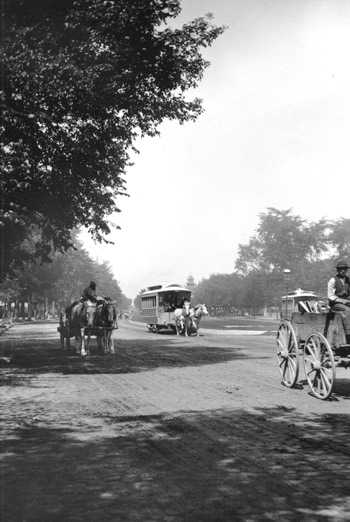
Grand Avenue (Wisconsin Avenue) from 9th Street, 1885
The Milwaukee, Racine & Kenosha Electric Railway was chartered on January 15, 1896, with trackage rights in Milwaukee with TMER&L Co. Construction of the line to Kenosha began in August. The 23 mile line was built with 60 pound rail. Service began from South Milwaukee station via Chicago Road to Racine on March 16, 1897, and to Kenosha (North Limits) on June 1. Eight days later service was extended into Milwaukee via trackage rights over the Carrollville line. The terminal was at City Hall Square. Twelve large 4-motor cars in the 100 series provided the original service. In 1899, the company was absorbed by MLH&T Co.
Both Racine and Kenosha had local streetcar service. Racine’s was called “Belle City Electric Railway” and was organized in 1883 and acquired by TMER&L Co. in 1897. Kenosha’s was called “Kenosha Electric Railway Company” and was organized in 1896 and purchased by Wisconsin Gas & Electric, a subsidiary of TMER&L Co., in 1912. With lines to Waukesha Beach and Kenosha now in successful operation, elaborate plans for expansion were successfully laid out. Lines were projected to Chicago, Sheboygan, Beloit and Lake Geneva. An outside company, the Milwaukee & Muskego Lakes Traction, was incorporated November 4, 1899, to build a line from 22nd Ave. (27th St.) and Greenfield to Muskego Lakes. Construction began soon after, and a considerable portion of right-of-way was graded. About 1900, this company was purchased by MLH&T Co. and, after acquiring a section of the Milwaukee & Beloit Railroad grade, construction was continued. On June 27, 1903, the line was opened from W. Water and Grand (Plankinton and Wisconsin) via Reed (S.2nd), Greenfield, old Beloit Road, 26th Ave. (31st), Burnham, and George (Becher) to Hales Corners. It was extended to St. Martin’s on June 21, 1904, and reached Muskego Lakes on September 1st.
In 1902, John I. Beggs succeeded Cromwell as President, and the company began plans for a block long office building and interurban terminal at 3rd and Sycamore (Michigan) in Milwaukee. The four story structure was completed in 1905 and named the Public Service Building. Cars of the Waukesha line began using it on January 1. On July 21, the Muskego Lakes and Kenosha line began using the new terminal. There were 10 tracks inside the building and 3 outside. In 1906, the company offices were moved into the building.
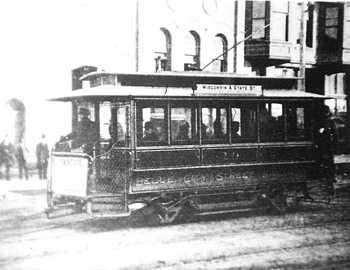
#10; Belle City, Main Street Racine
The Muskego Lakes Line was extended on July 3, 1907, to Phantom Lake, October 21 to Beulah Lake, and December 13 to East Troy. Extension of the Waukesha Beach Line was rushed the same summer. Two camps for construction gangs were opened, Camp No. 1 at Buena Vista and Camp No. 2 at Ixonia. At the peak of the project eight steam locomotives, one electric locomotive, three power shovels, one derrick, one pile driver, and over 200 dump cars were in use. The lines were built by the company’s own Way and Structures Department instead of hiring outside contractors. Many difficulties were encountered. Solid rock had to be blasted from Buena Vista to West Hartland Road. A 16 foot fill sank into Nagawicka Lake in the winter of 1906. The high standards of construction made this a costly project. Finally on June 3, 1907, service was extended to Oconomowoc. The portion to Watertown was opened on July 31, 1908, and was extended to the CNW depot in Watertown September 26th of the same year.
Construction of the last interurban line was completed the following summer with service to Waterford beginning June 19, Burlington July 2, and South limits on October 1, 1909. The 1200-volt portions (Beyond Fruitland and Waukesha Beach) were changed from AC to DC.
The proposed extension to Lake Geneva was blocked by pressure from Chicago millionaires who wanted to maintain the seclusion of their summer homes. A projected branch to Fort Atkinson was laid out by the fairgrounds in Watertown but was not constructed because of financial conditions.
By 1910, the TMER&L Co. system had nearly reached its peak in route mileage. Expansion after that date consisted only in short extensions to existing city routes, speeding up interurbans, and rolling stock modernization. By 1911, the construction of a new car maintenance area was needed. The shop was called Cold Spring shops and was close to the center of the city and within minutes’ running time from the center of the business district. As the city system grew, new car-houses were needed in the outlying districts. Fond du Lac replaced Chestnut and 12th Street Stations in 1912. Oakland replaced Farwell in 1916. Fiebrantz was opened in 1930 and replaced a small Milwaukee-Northern Terminal on that location.
After a brief strike on New Year’s Day, 1919, the company found it necessary to pay wage increases of as much as 7 cents an hour to its 2,500 trainmen. Due to this and other cost increases, it was found expedient to reduce platform time.
In 1909, two of the old deck roof city cars were rebuilt as a two-car, three-truck, and two-man train. This was designed to provide service on heavier lines. Twenty-two one-man cars replaced the 16 two-man. When the PSC ordered additional service on Routes 10 and 15 in 1926, permission was won to one-man these lines. No new cars were purchased and the first of the older cars (500’s) were rebuilt for this service.
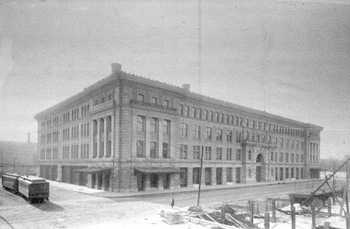
Public Service Building, Car #1214, Looking SW, December 25, 1905
The interurban line from Milwaukee to Sheboygan was developed independently of the TMER&L Co. and remained a separate corporation until 1928. A franchise was secured in 1906 to construct a line from Milwaukee to Sheboygan. The plan called for a total of 112 miles of track, including a double-track from Milwaukee to Cedarburg. From a junction at Cedarburg, there was to be one line to Port Washington and Sheboygan and another to West Bend and Fond du Lac. Railroad grade crossings were avoided by steel viaducts or concrete subways. One viaduct over the CM&StP tracks at Grafton was 765 feet long. Track right-of-way was 66 feet wide and was laid with 70 pound rail on cedar ties in gravel ballast. The first 19 miles between Milwaukee and Cedarburg were completed on Monday, October 28, 1907; the next 14 miles to Port Washington a few days later. Service on this portion of the line began on Sunday, November 2, 1907. The line was completed and opened in September, 1908. Cars started running to Cedar Grove on September 12th. Service on the entire line began on Tuesday, September 22, 1908. Cars entered Sheboygan over the trackage of the Sheboygan Light, Power and Railway and shared a common terminal with the local Sheboygan interurban line. The Northern Line started business with eight interurban cars and eight city cars. A station was opened at 5th and Kilbourn. City streetcar service was operated every ten minutes over the route between downtown Milwaukee and N. 6th and Atkinson. By 1920, weakened financial conditions in the country found it possible to join the TMER&L Co. By 1922, Milwaukee Electric purchased the Milwaukee-Northern stock. Operations of the Milwaukee-Northern were slowly integrated into TMER&L Co. The Terminal was closed and trains operated out of the Public Service Building. Offices in Cedarburg were consolidated with Milwaukee Electric offices in Milwaukee, and the old Port Washington Power Plant was closed.
In 1925, a new interurban station was built in Sheboygan, and on April 30, 1928, Milwaukee Northern was merged with the TMER&L Co. and became a division of its interurban line. During the depression of the 1930’s, a two million dollar grade separation was begun from Capitol Drive to Silver Spring in northern Milwaukee County. Only two crossings were ever completed and, for years after up until abandonment, cars used a temporary single-track around the construction area. Revenue declined through the thirties, and on September 23, 1940, the line was cut back to Port Washington. Wartime conditions caused a mild boom on the remaining route with many trips requiring an advance section as far as Cedarburg. During the war years, the former dining cars were used regularly on the line. The line between Port Washington and Milwaukee was abandoned on March 28, 1948.
In October, 1938, TMER&L Co. was broken up into two separate companies. The Wisconsin Electric Power Company operated Lakeside Power Plant; the Milwaukee Electric Railway and Transport Company assumed its transportation properties.
In 1945, the property was sold to Kenosha Motor Coach Lines and the South Sixth St. Line was abandoned in 1947. The first major abandonments in the post-war era were the Third, Burnham, and S.13th St. lines in 1948. The segment between Racine and Kenosha was abandoned on September 13, 1947, with abandonment of the remaining Kenosha-Racine operations on December 31st.
Oddly enough, several hundreds of thousands of dollars were spent on track renewal and improvements of rail facilities in the years 1948 to 1950. The city forced rebuilding of one-mile of track on South 2nd in 1948 since the company could not afford to pay abandonment fees. During 1949 and 1950, tracks on West Wells were rebuilt to comply with new street grades since no buses could be afforded to replace the lines.
The State St. Line was abandoned in 1950, followed by the important Fond du Lac and 12th Street lines in 1951. Once the Milwaukee and Suburban Transport Corporation took over in 1952, the company continued to substitute buses on lines. The Oakland, Kinnickinnic, and Farwell lines were dropped in 1953. The Wells Street car line from Wauwatosa to 70th & Greenfield was abandoned on March 2, 1958.
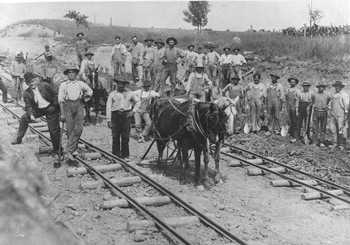
South of Cedarburg; Construction Crew, 1907
The interurban lines to Watertown, East Troy and Burlington were all experiencing financial difficulties during the late 1930’s. The last interurban line that was put into service was the first to be abandoned; the Burlington line was abandoned from St. Martin’s to Burlington on May 2, 1938. The East Troy Line from Hales Corners to East Troy was abandoned on August 12, 1939 with freight service being abandoned on September 4, 1939. The Village of East Troy purchased the line from Mukwonago to East Troy for village freight service for $10,000. The Watertown line from Oconomowoc to Watertown was abandoned on February 1, 1940, and on July 21, 1941, the line from Oconomowoc to Waukesha was abandoned. Waukesha west of downtown together with the Supercharger line in Milwaukee (a half-mile extension of the Burnham line built in 1943 to serve a war plant), was dropped on December 31, 1945. But shortages of new buses, together with sharply rising costs, slowed down the post-war abandonment program.
On September 2, 1949, control of the remaining Waukesha interurban passed to Jay Maeder of Cleveland. The new management began operating under the name “Speedrail” although the name was not legally changed to “The Milwaukee Rapid Transit and Speedrail Co.” until the following January. Six one-man interurban #60-65 acquired from Shaker Heights, Ohio, replaced the former equipment in all off-peak service in October. The profitable carload freight service, abandoned by the former owners, was restored.
During this period Speedrail was operating the Hales Corners suburban line for the Transport Company on a cost per mile basis. On December 3, 1949, the actual franchise was acquired together with ten, two-car suburban trains (#31-50) and two sweepers (#U4-U5). Schedules were greatly improved, and operations of the two lines were coordinated. A fare box and zone system replaced the old fare box collection plan. The old 1100 type cars were officially retired, but frequent breakdowns of the worn lightweights forced their continued use in tripper service to Waukesha as late as March, 1950. Five trains (#31-40) were equipped with seats and luggage racks, converted to single-end operation, and speeded up for the Waukesha Line. The balance filled in on West Junction rush hour runs.
An accident at Sunny Slope in February of 1950 badly damaged train #43-44. The unit was pulling through a crossover when the rear car was struck by westbound car #65. The train was retired, but #65 soon emerged from Cold Spring with a new front end and Speedrail’s orange and maroon replaced the Shaker Heights green and cream experimental colors. The only serviceable freight motor (#M-14) was wrecked shortly after in a runaway at the Schlinger interchange. This forced the use of 1100 type cars in freight service. Car #1121, one of a series rebuilt with heavier motors for pulling passenger trailers back in the twenties, was pressed into service with alterations. It was badly damaged by fire in October of 1950 and replaced by #1142 which traded trucks with the burned car.
The Public Service Building served as the line’s terminal, carhouse and offices. Some repair work was handled there, but major work was sent to the Transport Company’s Cold Spring Shops. The cost of using a desirable downtown location for these purpose were prohibitive, and from the beginning the management planned to erect a small shop and outside storage yard just east of Waukesha. Among other advantages, this location would have greatly reduced deadhead mileage since the heaviest traffic always flowed into Milwaukee in the morning and out in the evening. Lack of funds prevented this project from ever being started.
More cars (#300-301) were acquired from Shaker Heights in March, 1950. These two older St. Louis cars were never repainted, and, after a few months #300 was retired and salvaged for parts to keep its mate in operation. They were the regular equipment of the Hales Corners line with one car being adequate to provide the 90 minute non-rush hour service.
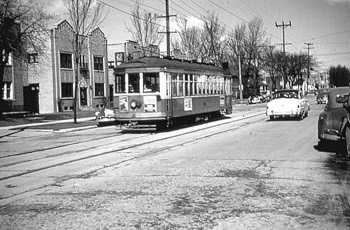
Car #935, 28th & Atkinson, March 20, 1954
The National Model Railroad Association held its Labor Day weekend convention in Milwaukee in 1950 and scheduled five special trains to Hales Corners as part of the activity on September 2, the very day that the Speedrail management marked its first anniversary. But tragedy struck when two of the specials collided head on just south of the National Avenue station. The southbound car (#1192-93) overrode the floor of the northbound lightweight train (#39-40) splitting the front car for half its length. Most of the 10 killed and 47 injured were in this car. Speedrail President Maeder was at the controls of the northbound car. He and two others were able to jump to safety before the impact. The collision took place shortly before 10 a.m.; the day was clear, but the location was a point of poor visibility with a reverse curve, grade and trees combining to obstruct the view. Car #39-40 was too badly demolished to be towed and was dumped off the embankment to be later dismantled on the spot. The heavy car was towed away and service restored at 7 p.m. Later investigations by the Public Service Commission and other authorities laid the blame for the accident to lack of a formal dispatching system and the fact that the northbound train was operating in a block which the Nachod signal system showed already occupied by an opposing train.
Only three days later, a less serious accident occurred at the West Junction interchange when Hales Corners bound car # 64 struck freight motor #1121. The light-weight car was badly damaged and had to be retired, although #1121 suffered only minor damages. The next day the company was notified that primary public liability insurance would be cancelled the following Saturday. The Public Service Commission ordered the line to suspend operations at 12:01 a.m., September 10, but late Saturday night a new insurance plan was negotiated, and the line received an eleventh hour reprieve. Thereafter only one car was permitted on the Hales Corners branch, and a shuttle service from West Junction was inaugurated during rush hours.
The company was experiencing difficulty in meeting current financial obligations, and in November, 1950, the property was turned over to a federal trustee. The trustee appointed Eldred M. Frey, former Transport Co. Superintendent of Way and Structures as General Manager, and a full-time Safety Engineer was retained. The name “Speedrail” was removed from timetables and painted out on all equipment. With merger financial resources at his disposal, the trustee made surprising progress. On time performance was restored. Written train orders and operating rules were brought back.
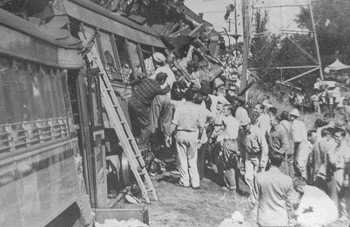
Cars #39-40 & 1192-3, Speedrail Accident, September 2, 1950
Expiration of the new insurance forced a 12-hour suspension of service early in March, 1951. “Temporary” bus service was inaugurated to parallel the rail lines. The outside bus operators continued after rail service was restored and took away traffic which the line could not afford to lose.
A completely modernized car #66 raised the hopes of commuters and public officials alike when it entered service on March 31, 1951 a former Lehigh Valley Transit car. It had been on the property over a year when the trustee decided that rebuilding was the one way to attract new investors to the company. The car featured a sensational exterior color scheme, pleasing pastel interior colors, new seats, improved ventilation, and new lighting. Two days later full-time through service to Hales Corners was restored.
Monthly losses remained high, and on May 1, fares were increased. June 4th brought drastically reduced schedules. The trustee reported that no responsible group was found to revitalize the line and that cash reserves were running low. He sought speedy abandonment, and early in the evening of June 30, 1951, Car #63 made the last trip to Hales Corners. Shortly before midnight train #37-38 completed the final run to Waukesha. The line was dismantled in the spring of 1952 by Hyman-Michaels of Chicago, and cars were scrapped at the Waukesha Gravel pit. This ended an era of mass transit between Milwaukee-Hales Corners and Waukesha and it took another seven years before local streetcar service ended in Milwaukee.
